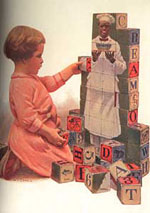By Marisa Helms
Minnesota Public Radio
February 14, 2002
The Cream of Wheat factory in Northeast Minneapolis is closing after nearly a century of operations. Cream of Wheat's new owner, Kraft Foods, is moving production to plants in Missouri and Ontario, Canada. The porridge that became Cream of Wheat was created by North Dakota millers in 1893. They moved production four years later to the then thriving milling city of Minneapolis.
Cream of Wheat expanded operations, and in 1928, the company relocated into its current home at Stinson Boulevard and Broadway in Northeast Minneapolis.
That factory is now up for sale, but the cereal and the Cream of Wheat brand will live on, as will the nostalgia associated with it.
| |
|
|
|
||
The Cream of Wheat Company was a major player in the competitive climate of cereal advertising of the early 20th century. The company's founders knew in order to sell a high turnover, low-profit margin product like cereal, they'd need to advertise - a lot. So, the company put its name on cups, bowls, dolls, and children's wood blocks.
Advertising historian and Smithsonian curator Charlie McGovern says Cream of Wheat made a name for itself in the early use of product licensing, something so familiar to 21st century consumers.
"Cream of Wheat's achievement is not one of origin but one of success and scale," according to McGovern. "They used a wide variety of products to advertise their image and they tied in the Cream of Wheat product, the cereal, to a wide array of everyday household items."
Through the decades, the hot cereal was produced in northeast Minneapolis, Cream of Wheat sold an image of wholesomeness, family, home, and security. This message repeated itself in print ads painted by well known artists. The Cream of Wheat jingle was heard regularly on the radio, as a sponsor of a children's radio drama called "Let's Pretend."
The ads nearly always featured children and sold Cream of Wheat as the parents' helper. It was easy to make, and it kept children strong and healthy.
In recent years, television ads targeted adult nostalgia for Cream of Wheat.
Though Cream of Wheat product licensing is less common these days, the proliferation of items carrying the Cream of Wheat brand created legions of collectors.
"I have what I think is probably one of the best private Cream of Wheat collections in the entire world," says Mick Liebfried, who worked at the Minneapolis Cream of Wheat factory for 36 years. He's a genuine admirer of the cereal and a major collector of company artifacts. He says he's got 3,000 different pieces.
| |
|
|
|
||
"I have many boxes of Cream of Wheat. I've got bowls, I've got cups, I've got tins, and some of the stand up store posters and store advertising. So it's been a lot of fun for me to go out and try to find some of this stuff," Liebfried says
But it was the black chef who became central to the marketing of the product. "It is both curious and instructive that so much of the sentiment around Cream of Wheat has to do with the Cream of Wheat chef," says McGovern, the historian. " (It is) an image that we find palpably racist and offensive today, yet for many people who remember Cream of Wheat fondly, there's an association of comfort and nurturance, with the illustrated figure of an African-American man."
The chef's image appears on every Cream of Wheat box and is prominent in nearly all the ads. He always has a smile on his face and a piping hot bowl of Cream of Wheat in his hands. The ads feature little, white children in different activities - in a cozy room at home, or playing outside throwing winter snowballs.
He appears in the background, benevolently watching over the kids with the promise of a hot bowl of Cream of Wheat.
Minneapolis actress and director Kim Hines is a collector of black memorabilia, including Cream of Wheat art featuring the image.
"When I look at that type of marketing campaign, it is wishful thinking on the part of the white people. It's like we want to go back to when the only thing you had to worry about is serving us and making us happy and the only thing we had to worry about was to make sure that all you black folks kept your place, and that it was always going to be this way," Hines says.
Hines says just like Aunt Jemima and Uncle Ben, Cream of Wheat's chef is offensive.
Marketers at Kraft Foods, Cream of Wheat's owner, view the Rastus figure in purely positive terms.
Kraft's Mary Jane Kinkaid says the original Cream of Wheat owners modeled the image after a chef they met in a Chicago restaurant in the late 1800s.
"It's just been a wonderful success story; that this person represents such quality and goodness to people on the package. That he is a chef, and chefs at that time, and still today, take great pride in presenting the best of the best in terms of their creations to the people that they're making food for. And that's exactly what our chef is doing," according to Kinkaid.
Kinkaid says the image of the black chef will stay on Cream of Wheat boxes because he remains a symbol of quality goodness, and because he is beloved by fans of the cereal.


